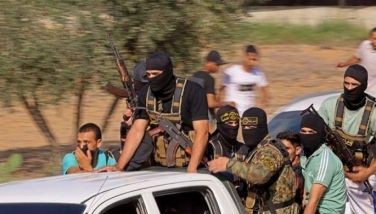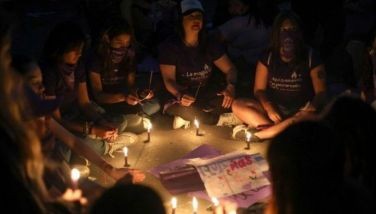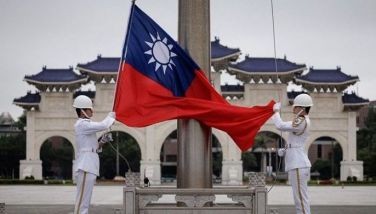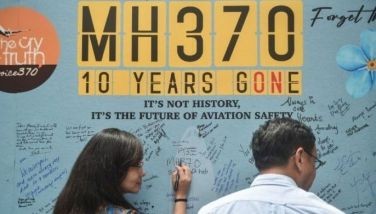Spacecraft for tourists breaks up on test flight
MOJAVE, California — A winged spaceship designed to take tourists on excursions beyond Earth's atmosphere broke up during a test flight over the Mojave Desert, killing a pilot in the second fiery setback for commercial space travel in less than a week.
Virgin Galactic's SpaceShipTwo blew apart Friday after being released from a carrier aircraft at high altitude, said Ken Brown, a photographer who witnessed the accident.
One pilot was found dead inside the spacecraft and another parachuted out and was flown by helicopter to a hospital, Kern County Sheriff Donny Youngblood said.
The crash area was about 120 miles (193 kilometers) north of downtown Los Angeles and 20 miles (30 kilometers) from the Mojave Air and Space Port, where the mid-morning flight originated.
British billionaire Richard Branson, founder of Virgin Galactic, has been the front-runner in the fledgling race to give large numbers of paying civilians a suborbital ride that would let them experience weightlessness and see the Earth from the edge of space. Branson was expected to arrive in Mojave on Saturday, as were investigators with the National Transportation Safety Board.
Branson released a statement Friday night saying it was "among the most difficult trips I have ever had to make" but that he wants to be "with the dedicated and hardworking people who are now in shock at this devastating loss."
"Space is hard — but worth it," Branson wrote. "We will persevere and move forward together."
The accident occurred just as it seemed commercial space flights were near, after a period of development that lasted far longer than hundreds of prospective passengers had expected.
When Virgin Group licensed the technology from Microsoft co-founder Paul Allen, who put $26 million into SpaceShipOne, Branson envisioned operating flights by 2007. In interviews last month, he talked about the first flight being next spring with his son.
"It's a real setback to the idea that lots of people are going to be taking joyrides into the fringes of outer space any time soon," said John Logsdon, retired space policy director at George Washington University. "There were a lot of people who believed that the technology to carry people is safely at hand."
Friday's flight marked the 55th for SpaceShipTwo, which was intended to be the first of a fleet of craft. This was only the fourth flight to include a brief rocket firing. The rockets fire after the spacecraft is released from the underside of a larger carrying plane. During other flights, the craft either was not released from its mothership or functioned as a glider after release.
At 60 feet long, SpaceShipTwo featured two large windows for each of up to six passengers, one on the side and one overhead.
The accident's cause was not immediately known, nor was the altitude at which the break-up occurred. The first rocket-powered test flight peaked at about 10 miles (16 kilometers) above Earth. Commercial flights would go 62 miles (99 kilometers) or higher.
One difference on this flight was the type of fuel.
In May, Virgin Galactic announced that SpaceShipTwo would switch to a polymide-based fuel — a type of thermoplastic. It had been fueled with a type of rubber called HTPB.
Scaled Composites, the company building the spaceship for Virgin Galactic, had extensively tested the new fuel formulation on the ground, President Kevin Mickey said. He characterized the new fuel as "a small nuance to the design."
Officials said they had not noticed anything wrong before the flight. The problem happened about 50 minutes after takeoff and within minutes of the spaceship's release from its mothership, said Stuart Witt, CEO of the Mojave Air and Space Port.
Virgin Galactic — owned by Branson's Virgin Group and Aabar Investments PJS of Abu Dhabi — sells seats on each prospective journey for $250,000. The company says that "future astronauts," as it calls customers, include Stephen Hawking, Justin Bieber, Ashton Kutcher and Russell Brand. The company reports receiving $90 million from about 700 prospective passengers.
Former NASA top space scientist Alan Stern has seats to fly on Virgin Galactic and isn't rethinking his plans.
"Let's not be Chicken Littles here," said Stern. "I want to be part of the opening of this future frontier."
Friday's accident was the second this week involving private space flight. On Tuesday, an unmanned commercial supply rocket bound for the International Space Station exploded moments after liftoff in Virginia.
Virgin Galactic plans to launch space tourism flights from the quarter-billion-dollar Spaceport America in southern New Mexico once it finished developing its rocket ship.
Taxpayers footed the bill to build the state-of-the-art hangar and runway in a remote stretch of desert in southern New Mexico as part of a plan devised by Branson and former New Mexico Gov. Bill Richardson. Critics have long challenged the state's investment, questioning whether flights would ever get off the ground.
SpaceShipTwo is based on aerospace design maverick Burt Rutan's award-winning SpaceShipOne prototype, which became the first privately financed manned rocket to reach space in 2004.
"It's an enormously sad day for a company," Burt Rutan told The Associated Press in a phone interview from his home in Idaho, where he lives since retiring.
Friday's death was not the first associated with the program.
During testing for the development of a rocket motor for SpaceShipTwo in July 2007, an explosion at the Mojave spaceport killed three workers and critically injured three others. A California Division of Occupational Safety and Health report said the blast occurred three seconds after the start of a cold-flow test of nitrous oxide, which is used in the propulsion system of SpaceShipTwo. The engine was not firing during that test.
- Latest
- Trending































